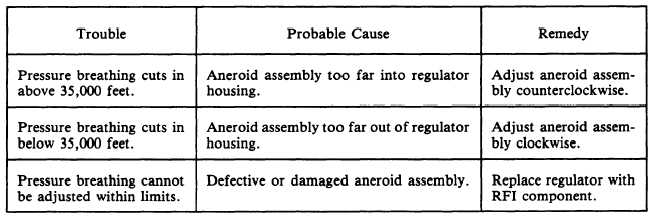CAUTION
OPEN FLUTTER DAMPENER VALVE
(J) 1/4 TURN. IF THE REGULATOR
CAUSES THE FLUID IN PRESS/SUC-
TION MANOMETER (4) TO FLUTTER,
OPEN FLUTTER DAMPENER VALVE
(J) SLOWLY UNTIL THE FLUTTER IS
ELIMINATED. IF AT ALTITUDE
DESCEND TO SEA LEVEL PRIOR TO
OPENING VALVE (J) AS THE PRESS/
SUCTION MANOMETER CAN BE
EASILY OVERLOOKED. WHEN
ASCENDING TO ALTITUDE MAIN-
TAIN AN OUTPUT FLOW OF 6.0
INCHES OF H2O.
NOTE: When increasing flows the inlet
pressure must be adjusted to maintain the
correct inlet pressure on N2 INPUT
PRESS gauge (27).
2. With OUTPUT valve (C) closed, read
PRESS/SUCTION manometer (4) and enter
the reading in the appropriate block on the
performance test sheet.
3. Adjust OUTPUT valve (C) to the
equivalent of 100 lpm as indicated on the OUT-
PUT manometer (1). Read the safety pressure as
indicated on the PRESS/SUCTION manometer
(4) and enter this figure on the performance test
sheet. The safety pressure must not be less than
0.50 nor greater than 2.5 inches in H2O for all
flows.
4. Adjust low-pressure regulator (N) to 90 psig
as indicated on the N2 INPUT PRESS gauge (27).
5. Repeat steps 2 and 3.
6. Close the altitude chamber door.
7. Ensure that REF PRESS SELECTOR
valve (O) is in the ALT. POSITION.
NOTE: A 6.0-inch flow in H2O must be
drawn with OUTPUT valve (C). Open
FLUTTER DAMPENER valve (J) 1/4
turn.
8. If the altitude chamber is inadvertently
taken above the test altitudes, open chamber bleed
valve (K) slowly and descend to the desired
altitudes. Close valve (K).
9. Using VACUUM CONTROL valve (B),
ascend to 34,000 feet as indicated on LOW
RANGE ALTM. (13).
10. Repeat steps 1 through 5.
NOTE: If low safety pressure is en-
countered, dispose of the regulator. If high
safety pressure is encountered at 34,000
feet, before disposing of the regulator
ensure that the pressure breathing has not
cut-in before 35,000 feet giving a false
indication of high safety pressure.
11. Leave the position of all controls and
connections unchanged, and continue to the
pressure breathing test.
PRESSURE BREATHING TEST. To per-
form the pressure breathing test, proceed as
follows:
NOTE: If problems are encountered
during this test, refer to pressure breathing
troubleshooting table 12-2 for adjustment
of the pressure breathing aneroid.
1. Open OUTPUT valve (C)and draw a flow
of 6.0 inches in H2O through the regulator. Using
VACUUM CONTROL valve (B) ascend to 35,000
feet as indicated on the LOW RANGE ALTM.
(13).
Table 12-2.—Troubleshooting (Pressure Breathing Test)
12-5


